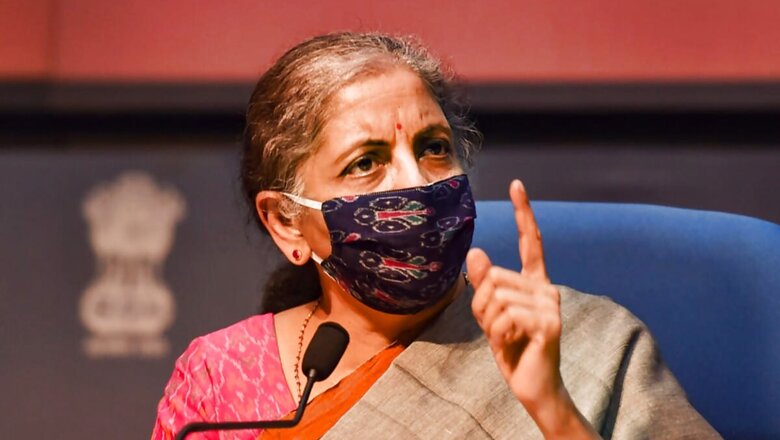
views
The Covid-19 pandemic has led to higher unplanned spending and decreased revenue collections. Although advance estimates put the economy’s contraction much below anticipated levels and growth is likely to rebound quickly, pressures remain. Hence, reviving the economy will be high on the government of India’s agenda.
The stand-off with China will require prioritizing defence spending. And, the China factor along with economic contraction will also fan the government’s protectionist impulses. On the revenue side, any radical tax burdens are unlikely although a successful divestment drive will be necessary. Union Budget 2021-22 will see an Atmanirbhar Bharat battling the Covid-19 and China challenge.
Expenses: Managing Threats, Spending for Growth
A large chunk of the Indian government’s budgetary expenses includes planned expenses like pensions, interest payments, salaries, planned subsidies, etc. How the government prioritizes its discretionary spending will be closely watched. Capital expenditure (capex) is one critical way through which the government can stimulate growth. Although there are expectations of high capex in infrastructure and health, one should temper their hopes as there is limited fiscal space available. Most experts anticipate an increase of not more than 10 per cent in capital expenditure. The standoff with China will mean earmarking some funds for defence modernization and procurement. Thus, defence capex will also feature prominently in the Budget, eating into the total capex and further limiting how much the government can spend on infrastructure and health.
The government’s vaccine rollout will likely feature prominently in the Budget. Vaccination is a crucial step to get the economic engine firing once more. Similarly, the farmers’ protest may prompt overhauling agriculture spending through subsidies, pricing support, and procurement. Providing support to farmers, women, and others who are marginalized will also be essential in the backdrop of the upcoming state elections (legislatures of four states and one union territory will hold elections in 2021) and the continuation of the earlier Atmanirbhar Bharat packages. Finally, as per periodic recapitalization exercises, monies will also be required for recapitalizing some of the public sector banks.
ALSO READ| Income Tax Deductions, Work From Home Benefits: 5 Things Middle Class Expects from Budget 2021
Unplanned expenses in fiscal year (FY) 2020-21 and higher expected expenses in FY 2021-2022 will mean that the government will miss its FY 2021 fiscal deficit target and aim for a much-higher fiscal deficit target in FY 2022. The fiscal deficit will also be higher as the GDP base will be lower due to economic contraction. But given the limitations on how much the government can realistically raise from markets and the threat of a higher deficit harming sovereign ratings, most experts expect the fiscal budget will not go beyond 8-9 per cent of the contracted GDP. In terms of long-term fiscal consolidation, there are talks of considering a fiscal deficit range and adopting a longer fiscal planning timeline.
Revenue: Prioritizing Divestment
India’s tax collection is crucial to support a pro-growth Budget, although the recent news is negative. Though Goods and Services Tax (GST) collections picked up in the latter part of FY 2021, direct tax recorded lower collections owing to reduced incomes and the earlier corporate tax reform. The low tax buoyancy and tightening fiscal strings make aggressive tax collections tempting—especially on high-income individuals and high-earning corporates. The Budget might see a Covid-19 cess for these groups. However, the government will stay away from any radical tax burden on individuals and companies as it could curtail investment and spending. Indirect taxes can rise though, through higher import duties and other tariffs. Other avenues to raise revenue can include amnesty schemes for tax evaders and a green tax on older vehicles. In terms of tax relief, soft incentives are likely for work-from-home employees and employers.
ALSO READ| Union Budget 2021: Levy a Covid Tax on the Ultra-Rich, Put Money in the Hands of Lower Income Class
For non-tax revenue, a divestment plan can create revenue space and decrease fiscal pressure. This will be especially critical as the government has not achieved its FY 21 divestment target—which was ambitiously set at Rs 2.1 lakh crore, with Rs 1.2 lakh crore to be raised through divestment of central public sector enterprises (CPSEs). Till now, about Rs 18,000 crore has been raised. It will be crucial for the government to raise revenues through a divestment plan which is successfully implemented. Divestment is likely to be supplemented by the sale of unused lands and other non-core assets of CPSEs.
Foreign Investors and Market Watchers
The Narendra Modi government will likely continue embracing trade protectionism. Custom duties and tariff hikes have become a regular feature of the Modi government budgets. There will likely be many import substitution and export promotion measures, in line with the government’s Atmanirbhar Bharat vision. Ears will also be up for any announcements that hint at the new Foreign Trade Policy 2021-2026, which is under formulation and will come into effect from April 1, 2021. Announcements about setting up of a bad bank to battle the impending non-performing assets crises can further increase interest of foreign investors interested in India’s emerging mergers and acquisitions landscape.
Markets will watch whether the government goes ahead with abolishing the long-term capital gains tax and await clarification on withholding tax on dividends for foreign portfolio investors. Other pending market wishes include reducing securities transaction tax and the commodities transaction tax.
The Budget, in many ways, will be inward-looking with the government preoccupied with reviving the economy and meeting internal and external challenges. Although there are high hopes, as there always are with any budget, the fiscal realities and resource constraints must moderate unrealistic expectations. Because, in times of crisis, survival is often enough.
Read all the Latest News, Breaking News and Coronavirus News here

















Comments
0 comment